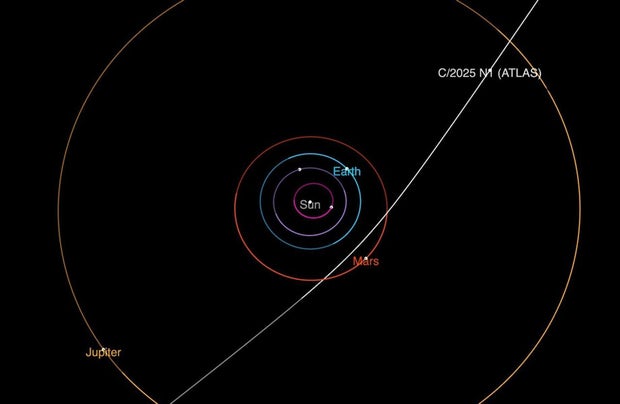NASA finds new interstellar comet passing through solar system
NASA has discovered a new interstellar comet that’s currently located about 420 million miles away from Earth.
The space agency spotted the quick-moving object with the Atlas telescope in Chile on Tuesday and confirmed it was a comet from another star system. The new interstellar comet’s official name is 3I/ATLAS.
It’s officially the third known interstellar object to pass through our solar system, and it poses no threat to Earth. The other two interstellar objects were 2I/Borisov, reported in 2019, and Oumuamua in 2017.
NASA
“These things take millions of years to go from one stellar neighborhood to another, so this thing has likely been traveling through space for hundreds of millions of years, even billions of years,” Paul Chodas, director of NASA’s Center for Near Earth Object Studies, said Thursday. “We don’t know, and so we can’t predict which star it came from.”
The newest visitor is 416 million miles from the sun, out near Jupiter, and heading this way at a blistering 37 miles per second.
NASA said the comet will make its closest approach to the sun in late October, scooting between the orbits of Mars and Earth — but closer to the red planet than Earth at a safe 150 million miles away.
Astronomers around the world are monitoring the icy snowball that’s been officially designated as 3I/Atlas to determine its size and shape. Chodas told The Associated Press there have been more than 100 observations since its discovery, with preliminary reports of a tail and a cloud of gas and dust around the comet’s nucleus.
NASA said 3I/ATLAS should remain visible to telescopes through September, but then it will pass too close to the sun to observe. It is expected to reappear on the other side of the sun by early December, allowing for renewed observations.
Based on its brightness, the comet appears to be bigger than the first two interstellar interlopers, possibly several miles across, Chodas said. It’s coming in faster, too, from a different direction, and while its home star is unknown, scientists suspect it was closer to the center of our Milky Way galaxy.
“We’ve been expecting to see interstellar objects for decades, frankly, and finally we’re seeing them,” Chodas said. “A visitor from another solar system, even though it’s natural — it’s not artificial, don’t get excited because some people do … It’s just very exciting.”
You may be interested

7/25: CBS Evening News Plus
new admin - Jul 26, 20257/25: CBS Evening News Plus - CBS News Watch CBS News Breaking down the latest Justice Department shakeup; Reporter's Notebook:…

Trump thinks Hamas will have to be ‘hunted down’ by Israel
new admin - Jul 26, 2025IE 11 is not supported. For an optimal experience visit our site on another browser.Congressman seeks to ban ‘surveillance pricing’04:21Now…

Lisa Jewell shares ‘gripping’ crime book she’s reading this summer | Books | Entertainment
new admin - Jul 26, 2025Going on holiday isn't complete without a good book or two in your bag. If you're going to be spending…

































